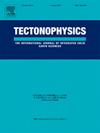The Tokyo Bay earthquake nest, Japan: Implications for a subducted seamount
IF 2.7
3区 地球科学
Q2 GEOCHEMISTRY & GEOPHYSICS
引用次数: 0
Abstract
Many earthquake nests (regions of highly concentrated seismicity isolated from nearby activity) exist beneath the Tokyo metropolitan area in Japan. The largest and most active nest is the Tokyo Bay earthquake nest located at depths of 60–70 km in the northern part of Tokyo Bay. The largest earthquake in the Tokyo Bay earthquake nest was an M6 earthquake over the last ~20 years. However, it is considered that the 1894 Meiji Tokyo earthquake (M7.0) occurred around the nest. Of note, no studies have explored the Tokyo Bay earthquake nest, and the spatial distribution of earthquakes remains poorly understood. Thus, this study is aimed at investigating the spatial characteristics of the seismogenic behavior of the Tokyo Bay earthquake nest through precise hypocenter relocation. The findings reveal that the earthquake nest forms a circular distribution of earthquakes (radius of ~10 km), and plate-interface earthquakes occur on a well-defined westward-dipping plane with a slightly steeper dip angle than the average dip angle of the subducting Pacific (PAC) plate. Moreover, the seismogenic behavior differs spatially, with many and few plate-interface earthquakes occurring in the second quadrant and third quadrant of the nest, respectively, and M ≥ 5 earthquakes occurring in the fourth quadrant. As the characteristic scale (radius and height) of the Tokyo Bay earthquake nest is comparable with that of the seamounts on the incoming PAC plate, I infer that the Tokyo Bay earthquake nest is caused by a subducted seamount. The size of the Tokyo Bay earthquake nest is sufficiently large to generate M ~ 7 earthquakes and can be a candidate for the hypocenter of the Meiji Tokyo earthquake.

东京湾地震巢,日本:对俯冲海山的启示
许多地震巢(与附近活动隔离的高度集中的地震活动区域)存在于日本东京市区的地下。最大和最活跃的巢是东京湾地震巢,位于东京湾北部60-70 公里深处。东京湾地震巢的最大地震是过去20 年来的M6地震。然而,人们认为1894年明治东京地震(M7.0)发生在鸟巢附近。值得注意的是,没有研究探索东京湾地震巢,地震的空间分布仍然知之甚少。因此,本研究旨在通过精确的震源定位来研究东京湾地震巢的发震行为的空间特征。结果表明,地震巢形成圆形地震分布(半径~10 km),板块界面地震发生在一个明确的西倾平面上,其倾角略大于俯冲太平洋板块的平均倾角。此外,孕震行为在空间上存在差异,在巢的第二象限和第三象限板块界面地震发生较多和较少,在第四象限发生M次 ≥ 5次地震。由于东京湾地震巢的特征尺度(半径和高度)与来袭PAC板块上的海山相当,推测东京湾地震巢是由俯冲海山引起的。东京湾地震巢的大小足以产生M ~ 7级地震,可以作为明治东京地震的震源候选。
本文章由计算机程序翻译,如有差异,请以英文原文为准。
求助全文
约1分钟内获得全文
求助全文
来源期刊

Tectonophysics
地学-地球化学与地球物理
CiteScore
4.90
自引率
6.90%
发文量
300
审稿时长
6 months
期刊介绍:
The prime focus of Tectonophysics will be high-impact original research and reviews in the fields of kinematics, structure, composition, and dynamics of the solid arth at all scales. Tectonophysics particularly encourages submission of papers based on the integration of a multitude of geophysical, geological, geochemical, geodynamic, and geotectonic methods
 求助内容:
求助内容: 应助结果提醒方式:
应助结果提醒方式:


